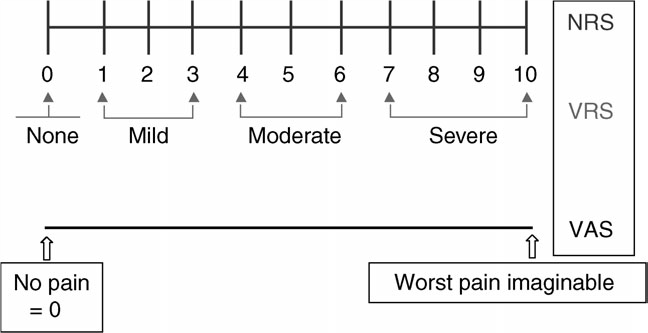R52.0
Pain should be assessed on arrival in the recovery room and at regular intervals postoperatively. Pain Scores should be recorded with other routine postoperative observations.
A Numeric Rating Scale (NRS) can be used to score pain:

Source: Breivik H, Borchgrevink PC, Allen SM, Rosseland LA, Romundstad L, Hals EK, Kvarstein G, Stubhaug A. Assessment of pain. Br J Anaesth . 2008 Jul;101(1):17-24.
The patient is asked to indicate on the scale the numeric value that best indicates their pain intensity or verbally if they cannot visualise the scale.
Severe pain (use lower doses if pain less):
- Morphine, IV, to a total maximum dose of 10 mg (See Appendix II, for individual dosing and monitoring for response and toxicity).
- Monitor conscious level and pulse oximetry continuously. Also monitor respiration, heart rate and BP at 5 minute intervals and for at least 20 minutes after the last IV morphine bolus.
In patients at high risk for respiratory depression, tramadol may be used instead of morphine as it causes less respiratory depression (although respiratory depression may still occur with tramadol).
Tramadol is a weak opioid agonist and increases spinal cord levels of serotonin and noradrenaline.
- Tramadol, IV, 50–100 mg over 3 minutes to reduce side-effects of nausea and vomiting (Specialist prescribed).
- Ceiling effect i.e. higher doses do not improve pain relief.
In addition to morphine or tramadol, diclofenac may also be given to supplement analgesia and reduce opioid requirements:
- Diclofenac, deep IM, 75 mg 12 hourly.
- Administer for a maximum of 2 days.
- Avoid the same injection site.
- Counsel patient prior to injection of adverse events (scarring) at inject site, if applicable.